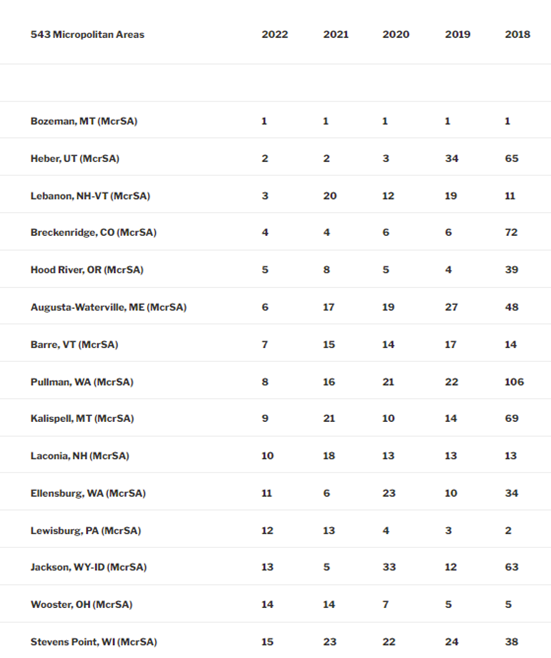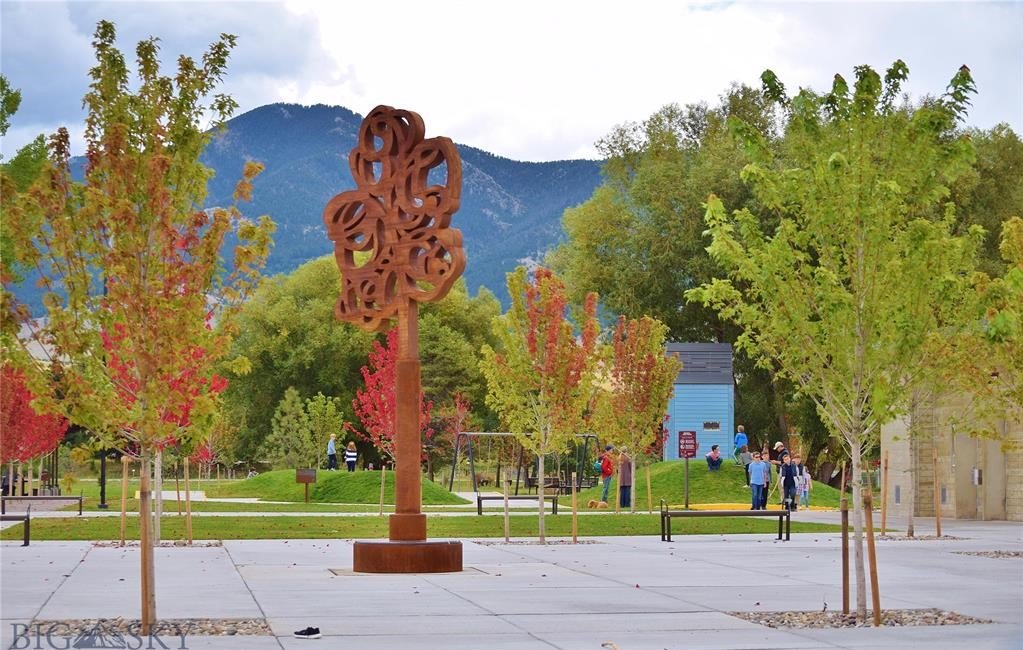Bozeman Demographics 2025 | Bozeman’s Population is ~59,050 in 202. | Bozeman’s growth rate is ~3% | The population of Gallatin County, Montana is ~129,265 (4.25%).
Bozeman Demographics: Population, Cost of Living, Climate, Rainfall, Temperature, Health, Housing, Economy, Education, Families, Income, Employment, Plan for Bozeman Growth

The first few years of the 2020’s saw a significant leap in Bozeman’s population that followed Covid!
Bozeman’s population growth rate was 2.8% in 2022, and, once again, Bozeman was the top small city–sixth year in a row–in the U.S!
Remember, population changes daily!
A fast-paced growth rate lead to a 6th year’s designation as the #1 fastest growing micropolitan city in the US for 2022 (macro vs micro = population below ~50,000).
Bozeman, MT has a top ten home-building rate, has a high cost of living, and is a tough place to find housing.
Have you ever wondered, “What’s the…population…of Bozeman, Montana or Gallatin County, MT?”
Bozeman is no longer considered a “micropolitan” city; this delineation ended in 2023 though Bozeman’s population surpassed 50,000 residents in 2020.
In Q1 2025, Bozeman has about 59,050 residents, up from 37,300 residents in 2010, a 56% increase. Gallatin County, with about 129,265 residents (in 2025), has grown over 40% since 2010, up from 89,513.
From city, county, and state data, one could infer Bozeman’s “metro” population to be around 100,000 residents in 2023.
In 2010, Bozeman had ~37,300 residents. By 2019, Bozeman’s population had grown 33.7%, adding 12,558 residents.
2023 Bozeman Economic Profile – Latest Census Figures, Gallatin County, MT
TIDBITS: According to the United States Census Bureau, “Bozeman, MT had the largest numeric gain among micro areas between 2015 and 2016, increasing by approximately 3,800 people.
Four of the five largest numeric-gaining micro areas were in the West: Bozeman, Montana; Hilo, Hawaii; Kalispell, Montana; and Oak Harbor, Washington.“
In late 2014, early 2015, the U.S. Census Bureau concluded Bozeman, MT was the sixth-fastest growing “micropolitan” area in the United States.
Looking at a snapshot in time, from July 1, 2013, to July 1, 2014, Bozeman had 39,860 residents, and Gallatin County, Montana’s population increased by 2.8% to about 97,310 residents.
How are Gallatin County, Montana and its communities handling growth? …through the Gallatin County Triangle Plan!
*Note: Demographic data from the U.S. Census Bureau and other sources are approximations, as data change is continuous.
*NEIGHBORHOOD | CITY | COUNTY | COUNTRY |
DEMOGRAPHIC | BOZEMAN, MT 59715, 59718 | GALLATIN COUNTY, MT | UNITED STATES |
| Area (mi²) | 19.12 | 2602.69 | 3,531,905.43 |
| Population (growth %) | 58,250 (2.8%) | 127,950 (3.2%) | 335,100,238 (.71%) |
| Population density/mile2 | 102.1/mi² | 34.4/mi² | 81.6/mi² |
| Percent male | 52.6% | 51.9% | 50.2% |
| Percent female | 47.4% | 48.1% | 49.8% |
| Median age | 32.6 | 32.9 | 38.8 |
| People per household | 2.3 | 2.36 | 2.39 |
| Median household income | $59,700 | $70,125 | $64,994 |
| Average income per capita | $36,530 | $38,890 | $35,384 |
| CRIME | |||
| Violent crime risk index | 1.0 | 2.0 | 3.0 |
| Property crime risk index | 2.0 | 4.0 | 3.0 |
| HOUSING | |||
| Median home values | $821,750 | $715,000 | $412,160 |
| Median age of homes | 27.0 | 22.0 | 27.0 |
| Home appreciation(/year) | 24% | 6% | 4% |
| Homes – owned | 50.4% | 56.0% | 64.7% |
| Homes – rented | 43.2% | 32.7% | 21.5% |
| Homes – vacant | 6.3% | 10.8% | 14.4% |
| Commuting by bus | 0.3% | 0.3% | 2.0% |
| Commuting by carpool | 12.3% | 12.4% | 14.4% |
| Commuting by auto | 67.3% | 71.1% | 71.0% |
| Working at home | 6.7% | 7.3% | 5.4% |
| FAMILY FACTS | |||
| Currently married | 42.7% | 50.4% | 57.5% |
| Never married | 38.5% | 32.2% | 24.6% |
| Divorced | 7.7% | 8.5% | 7.6% |
| Widowed | 4.2% | 3.6% | 7.4% |
| Separated | 6.9% | 5.0% | 2.8% |
| Married – with children | 18.9% | 23.5% | 28.1% |
| Married – no children | 25.1% | 27.9% | 31.0% |
| Single – with children | 5.2% | 6.1% | 9.4% |
| Single – no children | 50.7% | 42.2% | 30.3% |
| EDUCATION | |||
| High school graduates | 97.2% | 96.1% | 92.1% |
| College degree – 2 year | 5.0% | 5.1% | 8.2% |
| College degree – 4 year | 53.6% | 46.0% | 28.7% |
| Graduate degree | 17.5% | 12.9% | 7.2% |
| Expenditures per student | $4,325 | $5,481 | $5,909 |
| Students per teacher | 15.0 | 15.0 | 16.0 |
| Students per librarian | 481 | 404 | 912 |
| Students per guidance counselor | 940 | 519 | 552 |
| ECONOMY | |||
| Unemployment rate | 2.6% | 2.9% | 5.5% |
| Recent job growth | 4.6% | 3.1% | 0.7% |
| Future (10-year) job growth | 46% | 30.8% | 18.5% |
| Sales tax | 0.00% | 0.00% | |
| Income tax | 6.90% | 6.9% | variable |
| Cost of living index | 101.4 | 101.3 | 100.0 |
| HEALTH | |||
| Air quality | 35 | n/a | 48 |
| Watershed quality | 52 | 52 | 55 |
| Physicians per capita | 225.7 | n/a | 169.7 |
| Health cost index | 96.2 | 96.1 | 100.0 |
| Superfund site index | 83 | 81 | 71 |
| UV index | 3.8 | 3.8 | 4.3 |
| CLIMATE | |||
| Altitude | 4,869 | 4,778 | 1,062 |
| Rainfall (inches annually) | 18.3 | 16.3 | 36.6 |
| Snowfall (inches annually) | 84.5 | 55.7 | 25.2 |
| January average low temperature | 11.8 | 12.1 | 20.8 |
| July average high temperature | 81.0 | 81.9 | 86.5 |
| Days of precipitation annually | 111 | 102 | 101 |
| Days, mostly sunny annually | 186 | 187 | 205 |
| Comfort index (during hot weather) | 74 | 74 | 44 |


